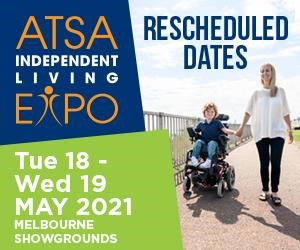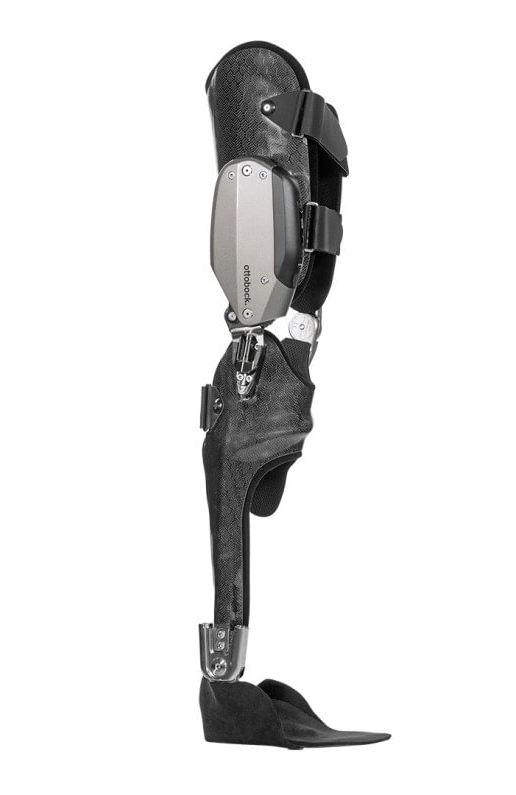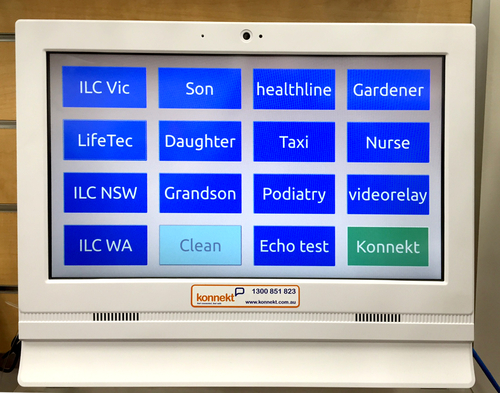ATSA Independent Living Expo

By: Steph Cantrill
Back in May, I was lucky enough to attend the Assistive Technology Suppliers Australia (ATSA) Independent Living Expo.
It was a remarkable time in recent Victorian history. Large-ish crowds were all gathered in the one place – mere days before Melbourne was placed into lockdown. Little did we all know what was just around the corner!
While it already seems like quite a while ago, here’s a brief summary of the events I attended, and some of my own thoughts and observations.

First session: The latest Knee-Ankle-Foot orthosis (KAFO) technology
This was a showcase of the C-Brace KAFO, which is an impressive device. Post-Polio Syndrome was one of the applicable conditions they mentioned for its use. Basically, it replaces the function of your quadriceps (and other muscles) and creates a gait pattern very close to that of a person without paralysis. There are sensors inside the brace that respond to feedback and make tiny adjustments in real time.
The brace is made of carbon fibre, with epoxy resin for the joint sections. Using the C-brace, you can go up steps in what we call a reciprocal gait (one foot per step), and it can handle uneven ground fine. You can also walk backwards. It even has a cycle mode for people who want to ride bikes. It’s not fully waterproof, but it’s ok with a bit of rain or splashing. It’s really quite a sophisticated product.
But it’s not for everyone. You have to be able to fully stabilise your trunk and stand freely. And you have to have enough strength in your hips to allow the swing-through of the walking pattern. Also, you can’t run or jump with this brace, so it’s not an athletic device per se.
It’s also highly specialised, and only available through a small number of certified providers. But, more prohibitively still, it’s also very expensive. Still, I’m sure it’s ideal for some – if they can get the funding!

Image from www.ottobock.com.
Second session: Changes to the building code
This session was about mandatory accessibility requirements for new dwellings. Livable Housing Australia, Universal Design Australia and others have been campaigning for years for a minimum standard of accessibility in the building of new homes.
Last year, many organisations (including Polio Australia) responded to the National Construction Code’s Consultation Regulatory Impact Statement. If you think the title is long, you should’ve seen the document… Anyway, it did lead to more attention, even if there weren’t immediate results.
When a coalition of organisations launched the Building Better Homes campaign, the momentum continued. You may have seen it on our social media pages – and you may have signed the petition. If so, you were one of 17,000 people supporting the campaign for accessibility.
And then good news came! Early this year, state and federal building ministers agreed to minimum standards for new builds, including at least one level entrance, a step-free shower and wider internal doors and hallways. Walls should be reinforced to allow the placement of grab rails.
The requirement will come into force in September 2022. The speaker at this session indicated that there is flexibility for jurisdictions to implement these changes in a way that best meets their needs. Cause for concern? A reason to keep campaigning? Let’s see.

This image of a not-so-accessible front door is from Wikimedia Commons.
Third session: Konnekt captioning videophone.
The pandemic has shown us how to be flexible in the ways we communicate. Many people have become absolute pros when it comes to using video technology. However, programs like Zoom or Skype can be difficult for some people, especially those with hearing loss.
The Konnekt phone can help people with hearing loss, low vision or reduced hand function to use video technology. It uses captions, which show the conversation in text on the screen in real time. It can be set to large font size with high contrast so it’s easy to read. The phone uses the person’s Skype account, which means they can connect with loved ones without everyone needing the same device.
And for people not comfortable with change, it comes with a typical phone receiver, so the user can talk into that instead of into the video. You can also add a list of trusted callers that the phone will answer automatically.
You can get a Konnekt phone by purchasing it outright and paying a monthly fee for the service, or renting the whole device on a per-month basis. It’s not particularly cheap, but it could be worthwhile for some. Feel free to visit their website to find out more.

This image of a Konnekt Videophone’s screen is from ILC Australia.
Fourth session: Navigating the NDIS assistive technology process – case studies and panel discussion
This discussion was mainly pitched towards practising clinicians, and focused on what’s available within the NDIS. The presenters talked a little about what the term “reasonable and necessary” means in relation to assistive technology – it must support the person’s goals, help them to engage in activities and facilitate social and economic participation.
As the rest of the session was mostly specific information for health professionals, I’ll leave this one there. Feel free to get in touch if there’s anything you’d like to know.

NDIS logo sourced from www.communities.qld.gov.au.
Assistive technology is a wonderful thing. Now all we need is funding! For more information about assistive technology, see our Aids and Equipment page. And if you believe that all Australians should have access to the equipment they need regardless of age, we’d love you to sign the petition for Assistive Technology for All.





You must be logged in to post a comment.